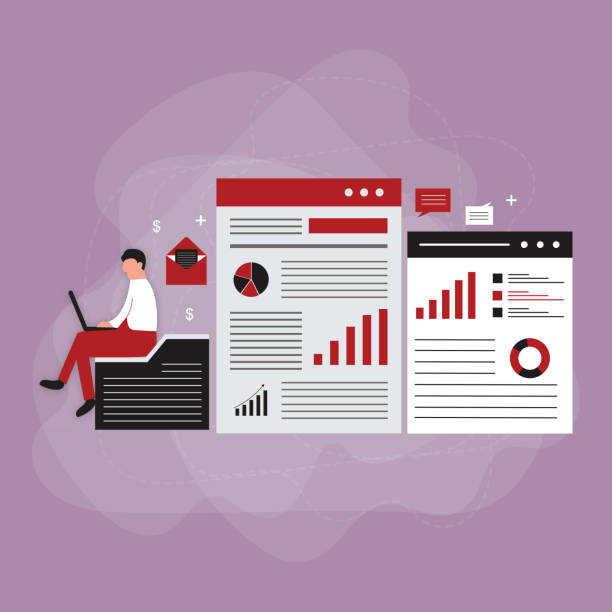Introduction and the Necessity of Multilingual Website Design
In today’s world, where geographical boundaries have no meaning in the virtual space, expanding businesses into international markets is an undeniable necessity.
Multilingual website design is no longer a luxury choice, but a vital strategy for any brand seeking to reach #GlobalAudience and increase its share in the #InternationalMarket.
Imagine having a website that only offers content in Persian; in this case, a huge portion of internet users around the world who speak other languages are excluded from your audience.
This is where the importance of multilingual website design stands out.
By providing content in multiple languages, you not only increase your reach to potential audiences but also enable them to interact with your brand in the language most comfortable for them.
This action builds a sense of trust and closeness in the audience and directly impacts conversion rates and customer loyalty.
Many businesses are still unaware of the immense potential of global markets and miss countless opportunities by overlooking the importance of web design.
This explanatory and educational article will show you step-by-step why and how you should move towards having a multilingual website and how you can leverage this powerful tool to achieve your global business goals.
Ignoring this strategy means overlooking a huge part of the potential for growth and development in today’s world.
Does your current company website not reflect your brand’s credibility and power as it should? Rasaweb solves this challenge for you with professional corporate website design.
✅ Increase credibility and visitor trust
✅ Attract more targeted customers
⚡ Click to receive free consultation!
Competitive Advantages of Multilingual Website Design
In today’s fierce digital competition, having a sustainable competitive advantage is key to success, and multilingual website design is considered one of the strongest of these advantages.
When your website is accessible in multiple languages, not only does your audience dramatically expand, but your brand appears more professional and committed in the eyes of international users.
This greatly helps in increasing brand credibility and creating a positive global image.
From an SEO perspective, a multilingual site allows you to rank for different keywords in various languages, which means increasing organic traffic from different parts of the world.
Search engines give more importance to sites that provide high-quality content relevant to the user’s language and geographical location.
This is a key analytical point that many companies overlook.
By providing content in the user’s native language, the bounce rate decreases, and the time users spend on the site increases, which are positive signals for search engine rankings.
Furthermore, this approach helps you understand cultural and linguistic differences and personalize your content in a way that is more appealing to local audiences.
These analytical and specialized advantages directly contribute to increased sales and market expansion, allowing you to be one step ahead of competitors who focus only on one language.
Approaches and Methods for Implementing Multilingual Website Design
Implementing multilingual website design requires choosing a suitable technical approach that aligns with your site’s goals and structure.
There are three main methods for this, each with its own advantages and disadvantages, and choosing between them is a specialized and guiding decision.
The first method is using subdirectories, such as example.com/en or example.com/fa.
This method is usually the most popular from an SEO perspective because all multilingual content is located under a single main domain, consolidating domain authority for all language versions.
The second method is using subdomains, such as en.example.com or fa.example.com.
This method operates somewhat more independently than subdirectories and can be suitable for larger projects that require separate management for each language.
However, it may require more effort in terms of SEO to build authority for each subdomain.
The third method is using country code top-level domains (ccTLDs), such as example.de for Germany or example.fr for France.
This method is the most powerful option for local SEO and provides strong signals to search engines that the site is targeted at a specific geographical region.
However, its implementation and management are more complex and costly, as it requires purchasing and managing multiple domains.
Additionally, many content management systems (CMS) like WordPress, with plugins such as WPML or Polylang, have greatly simplified the multilingualization process.
The best method should be chosen based on your budget, scalability, and international SEO goals.
| Approach | Advantages | Disadvantages | Suitable for |
|---|---|---|---|
| Subdirectories | Strong SEO, centralized domain authority, easier management | Requires organized URL structure, slightly more complex than a single-language site | Most websites, medium scalability |
| Subdomains | Greater independence, separate management possible for each language | Requires building SEO authority for each subdomain | Large projects with a need for strong separation |
| Country Code Top-Level Domains (ccTLDs) | Best for local SEO, strongest geographical signal | High cost, complexity of managing multiple domains, requires servers in each region | Large companies with precise regional targeting |
Challenges of Translation and Content Localization
Translating content for a multilingual website design goes beyond word-for-word transfer; this process involves a deep explanatory and educational understanding of culture and localization.
One of the biggest challenges is ensuring the accuracy and cultural relevance of content in different languages.
A mere machine translation can lead to misunderstandings, inappropriate tone, and even glaring errors that damage your brand’s credibility.
For example, idioms, specific cultural terms, or even differences in units of measurement and date formats must be carefully localized.
Localization also includes adapting images, videos, and page layouts for local audiences.
Some images may have a positive meaning in one culture, while being considered inappropriate or meaningless in another.
In addition, SEO Translation is another challenge.
Keywords that are effective in one language may not be used in another or may be searched for with different keywords.
Therefore, translation must be accompanied by new keyword research in each language to ensure that the translated content is also optimized and discoverable in local search engines.
Using native and specialized translators in each field, who are familiar with the culture as well as SEO principles, is essential for achieving the best results.
Neglecting these details can lead to wasted investment in multilingual website design and fail to achieve desired results.
Does your company website create a professional and lasting first impression on potential customers?
With professional corporate website design by Rasaweb, it not only represents your brand’s credibility but also paves the way for your business growth.
✅ Create a powerful and reliable brand image
✅ Attract target customers and increase sales
⚡ Get free consultation
SEO Optimization for Multilingual Websites (International SEO)
After implementing multilingual website design, the next crucial step is its specialized and guiding optimization for search engines at an international level.
International SEO has its own complexities and requires attention to details that are not present in single-language sites.
One of the most important details is the correct use of the hreflang tag.
This tag informs search engines (like Google) that a specific page has alternative versions in other languages or for specific geographical regions.
Incorrect use of the hreflang tag can lead to duplicate content issues and harm your site’s ranking.
In addition to hreflang, geo-targeting is also very important.
This is done through Google Search Console by selecting the target country for each version of the site (if you are using ccTLDs or country-specific subdirectories).
Site loading speed also gains additional importance in international SEO, as users from different parts of the world access your site with varying internet speeds.
Choosing suitable servers (CDN) and optimizing images and site code to ensure high speed in every region is vital.
Furthermore, special attention should be paid to keyword research for each language separately.
Common keywords in one language may differ in another, and direct translation is not sufficient.
Correct internal linking between different language versions also helps search engines better understand your site’s structure and distribute authority among pages.
Ignoring these principles in International SEO can result in not reaching your target audience, even with an excellent multilingual website.
User Experience (UX) in Multilingual Website Design
User Experience (UX) in multilingual website design is of high importance and directly affects user satisfaction and conversion rates.
A multilingual website should be designed so that users can easily select their desired language and access relevant content with minimal effort.
The first and perhaps most important point is the clear and accessible placement of the language switch button.
This button is usually located in the header or footer of the site, or in a visible dropdown menu.
This is a fundamental educational and guiding tip that must be observed.
The design should ensure that even after changing the language, the overall structure and layout of the site remain consistent so that the user does not feel confused.
Also, fonts and text measurements must be correctly adjusted in each language; some languages (like German) may have very long words that occupy more space, or others (like Arabic) are written from right to left and require a different design.
Ensuring visual and functional consistency across all language versions is essential.
Furthermore, making sure that all interactive elements, such as forms, buttons, and error messages, are correctly translated into the chosen language is crucial.
Fast site performance in every language and geographical location, as well as responsiveness to different devices (mobile, tablet, desktop), are also part of a desirable user experience.
Ignoring these points can lead to a poor user experience, even if your content is well translated.
Proper user experience on a multilingual website is key to retaining audiences and converting them into loyal customers.
Tools and Platforms Suitable for Multilingual Website Design
Choosing the right tool and platform for multilingual website design can significantly impact the success and ease of managing your site.
In today’s market, there are various options, each offering specific features and capabilities.
One of the most popular options is using content management systems (CMS) like WordPress, Joomla, and Drupal, which provide multilingual capabilities through dedicated plugins or modules.
For example, in WordPress, plugins such as WPML (WordPress Multilingual Plugin) and Polylang are among the most powerful tools for creating and managing multilingual content.
These plugins allow translation of posts, pages, categories, and even themes, and are compatible with SEO tools.
For Joomla, plugins like Falang, and for Drupal, native multilingual modules are available that provide specialized and guiding comprehensive capabilities.
In addition to general CMSs, e-commerce platforms like Shopify also offer multilingual capabilities natively or through third-party apps.
For businesses looking for custom and scalable solutions, programming frameworks like Laravel or Ruby on Rails also allow the development of multilingual sites using relevant packages and libraries.
The choice of platform should be based on the project’s specific needs, budget, the team’s technical expertise level, and future plans for site development.
This choice is an important step towards a professional multilingual website design.
Click here to preview your posts with PRO themes ››
| Platform | Multilingual Capability | Advantages | Disadvantages |
|---|---|---|---|
| WordPress | Plugins like WPML and Polylang | Large user community, easy to use, many plugins, relatively low cost | May require extensive optimization for very large scales |
| Drupal | Native multilingual capabilities | High scalability, strong security, suitable for complex projects | More complex for beginners, higher development cost |
| Joomla | Plugins like Falang | Good balance between features and ease of use, active user community | Fewer plugins than WordPress, sometimes requires optimization |
| Shopify | Native capabilities and third-party apps | Simple for online stores, strong support, no need for deep technical knowledge | Less flexibility in custom design, monthly fee |
Maintenance and Updating Multilingual Content
Maintaining and updating content on a multilingual website design is a continuous and vital process that requires careful planning.
After the initial launch, new content should be regularly added, and existing content updated.
This includes updating product information, blog articles, contact pages, and any other dynamic content.
The main challenge here is ensuring synchronization across all language versions.
If a change is made in the original version (e.g., Persian), it must be quickly reflected in all translated versions as well.
This is especially important for news websites or online stores whose content is constantly changing.
Using a Translation Management System (TMS) can facilitate this process.
TMSs allow you to track content changes and send only the changed segments for translation, which helps reduce translation costs and time.
Additionally, explanatory and news-related updates about Google’s algorithms and other search engines indicate that your international SEO strategy must also be regularly reviewed and updated to prevent any ranking drops.
Training the content and translation team to correctly use tools and follow standard processes is essential for maintaining quality and consistency across all languages.
Neglecting regular maintenance can lead to outdated content, translation errors, and ultimately, a poor user experience that can harm the credibility and ranking of your multilingual site.
This process requires continuous commitment for long-term success.
Are you dissatisfied with the low conversion rate of visitors to customers on your e-commerce site?
Solve this problem permanently with professional e-commerce website design by Rasaweb!
✅ Increase visitor-to-customer conversion rate
✅ Create an excellent user experience and build customer trust
⚡ Get free consultation
Success Stories and Important Tips for Multilingual Website Design
Reviewing thought-provoking and entertaining content from success stories in multilingual website design can be inspiring and clarify important points for you.
Many large international companies, by focusing on this strategy, have been able to penetrate new markets and significantly increase their sales.
For example, a software company that offered its services only in English, after implementing a multilingual website focusing on Spanish, German, and Japanese, saw a 30% increase in traffic from these regions and a 20% growth in conversion rates.
This shows that investing in a multilingual site has a strong return on investment.
However, to achieve this success, vital tips must be followed.
First, never replace machine translation with human translation; accurate and high-quality localization is key.
Second, consider international SEO from the very beginning, not as a post-completion step.
Third, pay special attention to user experience in all languages.
Ensure that the language switch button is clearly visible and that site navigation is logical and user-friendly in every language.
Fourth, take the process of maintaining and updating multilingual content seriously and plan for it.
Fifth, check site performance (loading speed) in all geographical regions.
And finally, emphasize data analysis.
Use tools like Google Analytics to monitor traffic, conversion rates, and user behavior in each language version to optimize your strategies.
These tips will help you leverage the full potential of your multilingual website design and stay safe from potential challenges.
Click here to preview your posts with PRO themes ››
Future of Multilingual Website Design and New Trends
The future of multilingual website design is rapidly evolving with technological advancements, and new trends are emerging that can revolutionize user experience and SEO capabilities.
One of the most important upcoming trends is analytical and specialized advancements in Artificial Intelligence (AI) and Machine Learning in translation.
Although machine translation does not yet reach the quality of human translation, with continuous progress, it has gained the ability to provide fast and acceptable translations for a large volume of content.
These technologies can accelerate the initial localization process and act as a powerful auxiliary tool for human translators.
For example, AI-powered tools can preserve the tone and style of the text and even offer suggestions for SEO keywords.
Another trend is the growth of Voice Search and smart assistants.
With the increasing use of assistants like Siri and Google Assistant, the need to optimize content to answer voice queries in different languages becomes more important.
This means focusing on natural language and complete sentences in content.
Also, Augmented Reality (AR) and Virtual Reality (VR) may, in the near future, offer new ways to interact with multilingual content, for instance, by instant translation of text on objects in the real world.
The emergence of Web 3.0 and the decentralized internet could also lead to the creation of new platforms designed from the outset to support multiple languages and localization.
These platforms may solve issues related to data ownership and servers that currently exist in multilingual website design.
Finally, focusing on personalizing content based on the user’s location and language, even before the user selects their language, can elevate the user experience to a new level.
All these trends indicate that the importance of multilingual website design will not only not decrease but will increase in the future.
Frequently Asked Questions
| Question | Answer |
|---|---|
| What is multilingual website design? | The process of creating a website whose content is available to users in more than one language. |
| Why should I make my site multilingual? | To reach a larger audience globally, improve user experience for non-native speakers, and increase sales or engagement. |
| What are the methods for implementing a multilingual site? | Using subdomains, subdirectories, or URL parameters, or using different country code top-level domains (ccTLDs) for each language. |
| Which method is better for SEO? | Generally, using subdirectories (e.g., example.com/fa/) is recommended for SEO because they share the main domain’s authority. |
| What is the hreflang tag and what is its use? | The hreflang tag is an HTML attribute that helps search engines understand which version of a page is appropriate for a specific language or region. |
| Is machine translation sufficient for multilingual site content? | Usually not. For a good user experience and to maintain credibility, professional human translation and content localization are essential. |
| What does Localization mean? | The process of adapting website content, design, and functionality to the culture, language, currency, and other specific characteristics of a target region or country. |
| What is the importance of language selection in multilingual website design? | Users should be allowed to easily select their desired language, usually through a clear button or menu in the site’s header. |
| What are the challenges in multilingual website design? | Managing content in different languages, maintaining consistency in design and user experience, multilingual SEO, and translation and maintenance costs. |
| What features should a suitable Content Management System (CMS) have for a multilingual site? | It should allow easy content management in different languages, support multilingual URL structures, and have plugins related to translation and localization. |
And other services of Rasa Web Advertising Agency in the field of advertising
Smart Brand Identity: Professional optimization to increase website visits using user experience customization.
Smart Advertising Campaign: An exclusive service for growing user engagement based on user experience customization.
Smart Advertising Campaign: Designed for businesses seeking digital branding through user experience customization.
Smart Marketplace: A fast and efficient solution for digital branding with a focus on optimizing key pages.
Smart Website Development: Designed for businesses looking to increase sales through optimizing key pages.
And over hundreds of other services in the field of internet advertising, advertising consultation, and organizational solutions
Internet Advertising | Advertising Strategy | Advertorials
Sources
The importance of multilingual website design for entering international marketsComprehensive guide to professional multilingual website designHow to succeed in global markets with a multilingual siteCompetitive advantages of multilingual website design
? Are you ready to transform your business in the digital world? Rasaweb Digital Marketing Agency, by providing comprehensive SEO solutions, content marketing, and personal website design, is your strategic partner in achieving sustainable success.
📍 Tehran, Mirdamad Street, next to Bank Markazi, Kazerun Jonubi Alley, Ramin Alley, No. 6















